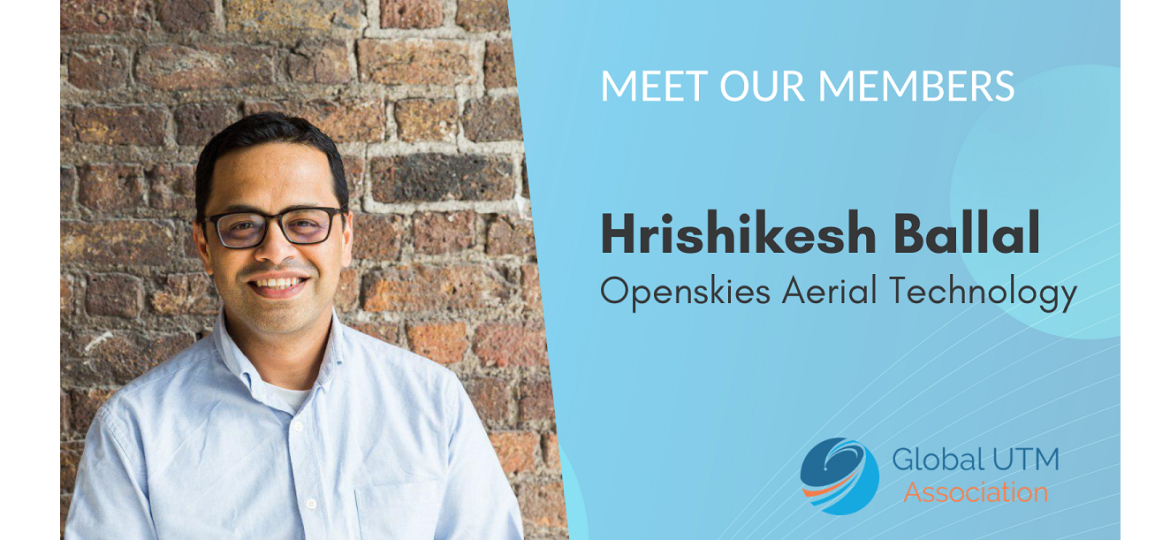
We talked to Hrishikesh Ballal, Founder and Managing Director of Openskies Aerial Technology, about his vision on the industry challenges and involvement in GUTMA . Openskies joined GUTMA almost a year ago and is a Member of the Standards Harmonization Working Group.
“Opensource tooling provides a way to develop independent, third-party verification of UTM services and de-risk implementations to the required level of software assurance.”
What is Openskies Aerial Technology and what is its role and involvement within GUTMA?
Openskies Aerial Technology is a company building software tooling for the UTM eco-system. What’s interesting about our work is that we build these products in the open-source. These products are compliant with the UTM standards that are being developed in standards development organizations like ASTM and others. These tools are available to all the stakeholders in the UTM eco-system and can help organizations in a number of ways. The adoption of these tools enables organizations to easily jump into the ecosystem and experience UTM standards. Our open-source software can dramatically speed up the internal software development processes and verify compliance to UTM standards and they allow organizations to flexibly extend this software for their particular needs.
To be specific, we build and maintain Flight Blender, a back-end data processing server that implements the APIs for UTM services as specified in adopted standards (e.g. ASTM for Network Remote ID, EuroCAE ED-269 for Geofence etc) these can be visualized via another front-end tool we build and maintain: Flight Spotlight. Tools like Flight Blender can be used by UTM software developers to easily test their systems against “real-world” scenarios of data exchange and interoperability. Since Flight Blender implements the USS <-> USS data exchange as specified by the ASTM standard, it is compliant with the software developed in the InterUSS project as well: the Discovery and Synchronization service (DSS) and automated software verification suite etc.
Within GUTMA, we work in the Standards Harmonization Working Group contributing to the verification processes and the associated reports and activities.
Tools like Flight Blender and Flight Spotlight can also be used to easily address a whole new class of problems around UTM for different stakeholders. I would like to elaborate on how these tools can be flexibly deployed for different cases depending on what you are trying to do. We have used these toolsets to develop and build reference implementations for “advanced” or “next generation” UTM services that leverage existing standards and capabilities. Organizations adopt it to enable integrations with their data feeds and data processing for e.g. for supplementary data service providers (SDSPs) etc. We utilize these tools to gather data on the airspace, how it is being used and develop reporting, analytics and mechanisms at the same time maintaining compatibility with existing standards. Since UTM services are all digital and therefore we can use these tools to conduct independent verification of implementations as well.
Adoption of open-source software provides confidence in peer reviews, unparalleled data sovereignty and maximum flexibility in decision making. Open source tooling provides companies, regulators and organizations with the option to “adopt and extend” existing capabilities for their own solutions and develop independent, internal capacity. These can dramatically speed up deployment time, reduce costs around software development and re-work / training. These tools are available to all stakeholders in the UTM eco-system and they help in de-risking the software implementation aspect of these standards by ensuring that the organization builds on top of a well-tested, open foundation. As a company, by building software in the open-source we have developed expertise in how the standards work and how UTM software can be verified.
According to you, what are the biggest industry challenges at the moment?
In my opinion, the major challenge facing the UTM industry is around the lack of clarity around the market / business model. UTM is an enabling capacity and there is an open question as to how the UTM business model will work. When the costs of development and the costs associated with maintenance and certification are considered, it is unclear what kind of company a USSP has to be to ensure profitability and safe operations. Of course, some companies have figured their business model/costs but I am speaking broadly as an industry. Therefore, I believe that it is an exciting time for the industry and that open-source has a role to play in this as well.
GUTMA is working on this topic via the Market Working Group and I am looking forward to engaging there.
ABOUT HRISHIKESH BALLAL
Dr. Hrishikesh Ballal is the Founder and Managing Director of Openskies Aerial Technology Pvt. Ltd. He has extensive experience developing technologies, protocols, and interfaces in the context of secure drone operations and UTM. He is the Founder/Primary Technical Lead to well-established open-source projects/communities in the context of unmanned aviation: Flight Blender, Flight Spotlight and Aerobridge. For more information about him see: www.hrishikeshballal.net
Official website: {Open}skies.sh (openskies.sh)
LinkedIn: https://www.linkedin.com/company/openskies-sh

